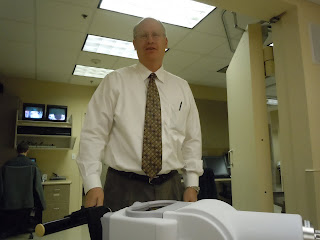Prostate Cancer Part II
Brachytherapy (pronounced by most as 'brakie-therapy'),is a high dose targeted internal radiation. This type of treatment is used for several other cancer types as well, including breast, lung, cervical, but I will confine my discussion to the treatment of prostate cancer.
I was given the option of several different treatment types, including (1) prostatectomy, which is the surgical removal of the prostate and associated tissues, (2) external beam radiation, where low dose radiation is targeted at the cancer from the outside, which is less invasive but requires as many as 40 or more treatments, (3) hormonal, which involves the injection of certain drugs into your system to suppress the growth of male hormones that speed the cancer's growth , and (4) brachytherapy.
I chose brachytherepy for several reasons. First, it involves three treatment days separated by two week recovery periods and you are done; second, it leaves all your organs in place so at least you have a chance of them healing and resuming normal function; third, it is very targeted and specific, involving minimal damage to surrounding tissues and organs; fourth, Dr. Ray Richards comes very highly recommended by others who have had the treatment; and fifth, it just seemed like the right thing to do.

Dr. Ray Richards, Radiation Oncologist
My treatments began on January 19th with a 6:00am arrival at the Coral Desert Surgical Center in St. George. Starting about 24 hours prior you have to go through a prep procedure which involves taking a stool softener in the morning, then after a normal lunch begin fasting. You are allowed clear liquids until midnight and after that only a sip of water to take any required meds. Before bed you take two Imodium and a fleets enema. First thing next morning two more Imodium. This prepares your bowels by basically stopping them so that they don't interfere with the procedure the next day.
After checking in at the surgical center you are taken to the prep area where you remove clothing and put on a gown and elastic stockings. They give you some nausea medicine, take your vitals, have you sign consent forms, put in an IV and then wait.
the 'prep' room
Around 7:00am you are taken into surgery, where you are moved onto the surgical table where you sit up while they give you a local anesthetic to numb things a little before giving you the shot in the spine to deaden your lower body. As you feel your feet start to tingle and numbness spread they lay you down and put your feet is stirrup-like apparatus so you are basically in the birthing position. To guide them in what is to follow, they put in a catheter through your penis into your bladder, position a fluoroscope over your abdomen and insert an ultrasound probe into your rectum.
I can see the ultrasound monitor as I lay there listening to the doctors plotting the procedure. The team consists of Dr. Ray Richards, radiation oncologist, Dr Greg Taylor, urologist, a couple of nurses and of course the Anesthesiologist. You know they are doing things to you but it is rather detached, almost like it is someone else because you can feel nothing. It is a little errie watching the monitor and seeing the catheters slowly being inserted, knowing that they are invading your body. It is good that you are convinced it will help, but just the same there is nothing you can do except perhaps scream. Instead I tell the doctors I am doing fine.
They place a template on the perineum between your scrotum and anus. Through this template they insert 18 thin plastic catheters into the prostate gland as pre-determined by computer analysis using the biopsy to determine where to place each one. When this is done a CAT scan assures that they are in the correct position, and you are ready to be 'illuminated'.
the afterloader
nurse Tyler connecting the afterloader
After a short wait you are wheeled into the lead-lined room, and connected to a machine called an afterloader. Each of the 18 catheters is connected to a corresponding port on the afterloader. This machine contains a single highly radioactive iridium pellet at the end of a wire. The pellet is pushed into each of the catheters one by one under computer control. The computer controls how long the pellet stays in each catheter (dwell time), and where along the catheter it should pause to release its radiation (dwell positions). This very precise treatment takes around 20 minutes, after which you are taken to a recovery room for a five hour wait.
During the five hour recovery you can read, watch dvds, visit eat or sleep. After the rest they take you back and hook you to the afterloader again and repeat the treatment. When this is finished they remove the 18 catheters from your prostate and the one from your bladder. They make sure that you are passing urine and that there are no blood clots, and that the bleeding has stopped, then put a diaper on you and help you get dressed. Then they walk you to your vehicle and send you home. The entire event has lasted between eight and nine hours.



